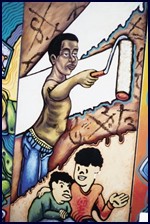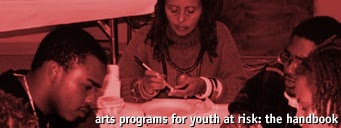 |
Research for the YouthARTS Development Project involved interviews and focus groups with representatives from arts programs for youth at risk, and a review of the literature on arts programs and juvenile justice theories and programs.
From this research, many best practices emerged. Early on, these findings were incorporated into the arts programs developed by the three YouthARTS demonstration sites.
Finding No. 1: Common Elements of Successful Programs
- Successful programs recognize that art is a vehicle that can be used
to engage youth in activities that will increase their self-esteem.
- The delivery of the program is a collaborative effort among the artist, social service provider, teacher, agency staff, youth, and family.
- Successful programs recognize and involve the community in which
the youth live.
- Programs that involve the youths� families provide the opportunity for
the greatest impact.
- Successful programs provide a safe haven for youth.
- An age-appropriate curriculum is essential in developing
appropriate activities.
- Successful programs emphasize dynamic teaching tactics such as hands-on learning, apprentice relationships, and the use of technology.
- Successful programs provide youth with opportunities to succeed.
- Successful programs culminate in a public performance or exhibition in an effort to build participants� self-esteem through public recognition.
- Program planning is critical and needs to address the following: goals of program; site selection; population; developing relationships among team members; methods for youth involvement in planning; curriculum design; transportation; safety; incentives; behavioral requirements; program growth; balance of art program and other program objectives; balance
of process and product; student recognition of achievements; family, community, and volunteer involvement.
- Successful programs are designed with evaluation built in from the beginning.
Finding No. 2: Training
- The teams that work with youth need to be trained in team building, communication skills, and organizational skills. They need to receive training in collaboration to better understand one another�s language, point of view, and the benefits that each brings to the team.
- The team needs to be trained in effective methods for working with youth from special populations, including some behavior management, adolescent psychology, and familiarization with the juvenile justice system.
- To maximize program effectiveness, the team needs to be trained in curriculum design, or a trained curriculum specialist needs to be involved.
- Training needs to start with the interview process and be ongoing.
- Training should be practical, address issues identified by team members, and be presented by a variety of trainers with expertise in the issue areas.
- Peer training and opportunities to share successes and failures
are essential.
- Specialized training needs to be integrated into ongoing training sessions whenever possible.
Finding No. 3: Evaluation
- To evaluate an arts program for at-risk youth, program staff must clearly define the program goals and intended outcomes, and monitor and document the program implementation and service-delivery process.
- Process evaluations�which examine program implementation and service delivery�are currently the most common type of evaluation and can be used to describe a program and to provide an avenue to refine the program continually. Evaluation should not just measure the impact on youth; it should also be used to improve the program.
- The evaluation measures most frequently used to determine the effects of arts programs on youth at risk are journals, portfolios, surveys, and artist observations. Such measures can be incorporated into program activities; for example, students� art portfolios or journals can be used as evaluation tools, embedding the evaluation within the program.
- Program-specific factors such as staff ratios, hours of contact, and duration of contact are likely to have a major impact on program outcomes. These program factors should be documented in
process evaluations.
- Individual, family, and community factors may influence program outcomes as well. The impact of multiple factors must be taken into account in measuring program effectiveness.
- There are few valid research studies that show the impact of arts-based programs on youth at risk. (A control group or comparison group is necessary to show a causal relationship between the art activities and intended outcomes).
Finding No. 4: Risk and Protective Factors
- Research conducted as part of the juvenile justice system�s work in reducing delinquent behaviors has identified risk factors and protective factors associated with adolescent problem behaviors.
- A number of these risk factors may be influenced by youth arts programs, for example: low neighborhood attachment; lack of commitment to school; alienation and rebelliousness; and friends who engage in problem behavior.
- Effective youth arts programs contain activities that are designed to reduce the influence of risk factors by providing opportunities for youth to learn new skills and by recognizing individual youth�s efforts. This approach, according to juvenile justice literature, promotes bonding, which helps youth cope with the negative influence of risks they face.
- To date, there has been mostly anecdotal information that youth arts programs are effective in engaging youth through the arts, resulting in improved self-esteem, increased skills, and improved school or work behavior.
- To demonstrate causality between youth arts programs and identified risk factors, a scientifically acceptable outcome evaluation with a control or comparison group needs to be conducted.

|  |
 
|
 |


